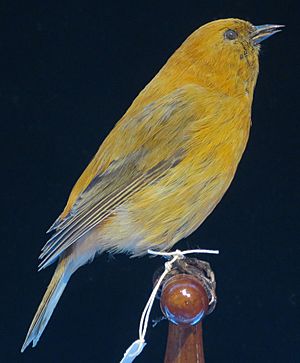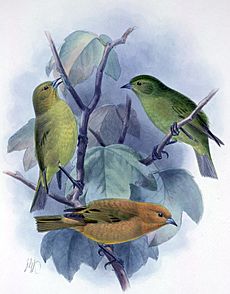Maui ʻakepa facts for kids
Quick facts for kids Maui ʻakepa |
|
|---|---|
 |
|
| Specimen at the Bishop Museum | |
| Conservation status | |
| Scientific classification | |
| Genus: |
Loxops
|
| Species: |
ochraceus
|
| Synonyms | |
|
Loxops coccineus ochraceus |
|
The Maui ʻakepa (Loxops ochraceus) was a special type of ʻakepa bird. It lived only on the island of Maui in the Hawaiian Islands. This small bird used to be very common all over the island.
Sadly, new things like mosquitoes and other animals were brought to Maui. These new arrivals caused the number of Maui ʻakepa birds to drop. Because of this, the bird is now thought to be critically endangered. This means it is at a very high risk of disappearing forever. The last time anyone reported seeing this bird was in 1988.
Contents
What Did the Maui ʻakepa Look Like?
The Maui ʻakepa was a small bird, about four inches (10 cm) long. Its feathers were a dusty green color. It had a unique beak that crossed at the tip, just like other birds in its group, called Loxops.
When it sang, its call was a soft, shaky whistle. This whistle would end with a long, rolling sound called a trill. When it flew from tree to tree, it looked like a quick, fluffy green ball.
What Did the Maui ʻakepa Eat?
The Maui ʻakepa mostly ate tiny creatures like spiders and other small bugs. It also drank sweet liquid called nectar from different flowers. Some of its favorite flowers included the ʻōhiʻa tree, the naio plant, and a type of lobelia flower.
Why Did the Maui ʻakepa Disappear?
Like many birds in Hawaii, the Maui ʻakepa started to have problems. This happened when new plants began to grow where its usual food plants used to be. For example, plants like raspberries grew very fast. They took over the space and made it hard for native plants to survive.
These new plants also brought new animals, like frogs and insects. These new creatures started eating the native insects that the Maui ʻakepa needed for food. This meant less food for the birds. The new arrivals also brought more pests and problems.
The Maui ʻakepa was also not very strong against diseases. A sickness called avian flu spread quickly. This was because mosquitoes, which carry the disease, spread across the island's lower forests.
When Did the Decline Start?
The number of Maui ʻakepa birds began to drop in the early 1900s. Back then, it was still a common bird on Maui. But ships brought mosquitoes and other animals and plants to the island. These new species started living there.
The birds' homes in the lower forests became filled with mosquitoes. Higher up in the mountains, unusual plants and animals also started to appear. These new things damaged the birds' natural living areas. With so much of Maui changing, the birds found it very hard to find safe places to live.
Efforts to Help
People did not start trying to breed these songbirds in special safe places until 1995. But by then, it was already too late for the Maui ʻakepa.
In 1988, only one Maui ʻakepa was seen. This happened when a group of researchers went to study birds in Maui's Hanawi Reserve. Before that, other trips had found small groups of the birds scattered in the reserve. The largest group found in the 1970s had only ten Maui ʻakepa birds.
Today, you can only see the Maui ʻakepa as a preserved specimen in museums. In the 1970s, a few of these birds were still living in the East Maui Watershed area and nearby reserves.
See also
 In Spanish: Akepa de Maui para niños
In Spanish: Akepa de Maui para niños



